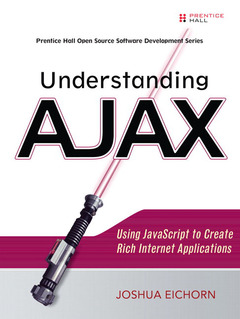Understanding AJAX: Using JavaScript to Create Rich Internet Applications Joshua Eichorn 0132216353
PART I Chapter 1 What Is AJAX? 1.1 Rich Internet Applications 1.2 AJAX Defined 1.3 Technologies of AJAX 1.4 Remote Scripting 1.5 Gmail Brings XMLHttpRequest into the Mainstream 1.6 New Name: AJAX 1.7 Summary
Chapter 2 Getting Started 2.1 XMLHttpRequest Overview 2.1.1 XMLHttpRequest::Open() 2.1.2 XMLHttpRequest::Send() 2.1.3 XMLHttpRequest::setRequestHeader() 2.1.4 XMLHttpRequest::getResponseHeader() and getAllResponseHeaders() 2.1.5 Other XMLHttpRequest Methods 2.1.6 XMLHttpRequest Properties 2.1.7 readyState Reference 2.2 Cross-Browser XMLHttpRequest 2.3 Sending Asynchronous Requests 2.4 AJAX Without XMLHttpRequest 2.5 Fallback Option 1: Sending a Request Using an IFrame 2.5.1 Creating a Hidden IFrame 2.5.2 Creating a Form 2.5.3 Send Data from the Loaded Content to the Original Document 2.5.4 Complete Iframe AJAX Example 2.6 Fallback Option 2: Sending a Request Using a Cookie 2.7 Summary
Chapter 3 Consuming the Sent Data 3.1 Document-Centric Approaches 3.1.1 Adding New HTML Content to a Page with AJAX 3.1.2 Consuming XML Using DOM 3.1.3 Consuming XML Using XSLT 3.2 Remote Scripting 3.2.1 Basic RPC 3.2.2 SOAP and XML-RPC 3.2.3 Custom XML 3.2.4 JavaScript and JSON 3.3 How to Decide on a Request Type 3.4 Summary
Chapter 4 Adding AJAX to Your Web Development Process 4.1 Changes to the Development 4.1.1 Enhancement-Driven Changes 4.1.2 AJAX in Action: Removing a Popup User Search 4.1.3 Changes Caused by Creating an AJAX-Driven Application 4.2 Integrating AJAX into a Framework 4.3 JavaScript as a Primary Development Language 4.4 Problems Created by the New Development Paradigm 4.5 Advantages to Using a Library 4.6 Reasons to Build Your Own Library 4.7 How Open Source Fits into the Mix 4.7.1 Evaluating an Open Source Library 4.7.2 Open Source Libraries in Relation to Commercial Libraries 4.8 Use Case for Building: The Firefox Counter 4.9 Use Case for Downloading: An Intranet Web Site 4.10 Summary
Chapter 5 Getting the Most from AJAX 5.1 Goals of AJAX 5.1.1 Increasing Interactivity 5.1.2 Decreasing the Time Required to Perform Actions 5.1.3 Reducing Bandwidth Use 5.1.4 Creating Rich Applications 5.2 Measuring Improvements 5.3 Promises and Problems of Combining AJAX with Other New Technologies 5.3.1 Combining AJAX with Flash 5.3.2 Scalable Vector Graphics (SVG) 5.3.3 XML User Interface Languages 5.4 Summary
Chapter 6 Usability Guidelines 6.1 Defining Usability 6.2 Usability Guidelines 6.2.1 Keep the User's Expectations in Mind 6.2.2 Provide Feedback to Actions 6.2.3 Maintain the User's Focus When Adding Content 6.2.4 Keep the Ability to Undo Actions 6.2.5 Know If You Are Developing an Application or a Web Site 6.2.6 Only Use AJAX Where It Has the Greatest Effect 6.2.7 Have a Plan for Those Users Without XMLHttpRequest 6.3 Common Usability Problems 6.3.1 Stealing Focus with Validation Messages 6.3.2 Preventing Undo with Autosave 6.3.3 Updating Sections of a Page Withoutthe User Realizing It 6.3.4 Breaking Bookmarking by Using AJAX to Load Entire Pages 6.3.5 Making AJAX Required on a Web Store 6.4 Summary
Chapter 7 AJAX Debugging Guide 7.1 Two Sides to Debugging 7.2 Looking at AJAX Communications 7.2.1 Building an AJAX Logger 7.2.2 Using the Logger 7.2.3 Firebug: A Firefox Debugging Extension 7.2.4 Fiddler 7.2.5 General Debugging Scenarios 7.3 JavaScript Debugging Tools 7.4 JavaScript Exceptions 7.5 Dumping Variables 7.6 Summary
PART II
Chapter 8
Libraries Used in Part II: Sarissa, Scriptaculous
8.1 Overview of the Use Cases
8.2 Libraries Used in Part II of This Book
8.3 Sarissa
8.3.1 Installation
8.3.2 Making an AJAX Request
8.3.3 Basic XML Features
8.3.4 Working with DOM Documents
8.3.5 Using XPath to Find Nodes in a Document
8.3.6 Transforming XML with XSLT
8.3.7 Sarissa Development Tips
8.4 Scriptaculous
8.4.1 Installation
8.4.2 Visual Effects
8.4.3 Hide/Show Pairs
8.4.4 Drag-and-Drop
8.4.5 Sortables
8.4.6 Slider Control
8.4.7 Scriptaculous Development Tips
8.5 Summary
Chapter 9 Libraries Used in Part II: HTML_AJAX
9.1 HTML_AJAX
9.1.1 Installation
9.1.2 HTML_AJAX JavaScript API
9.1.3 Remote Stub AJAX
9.1.4 Using HTML_AJAX_Action
9.1.5 JavaScript Behaviors
9.1.6 JavaScript Utility Methods
9.1.7 PHP Utility Methods
9.1.8 HTML_AJAX Development Tips
9.2 Summary
Chapter 10 Speeding Up Data Display
10.1 Overview of the Sun Rise and Set Data Viewer
10.2 Building the Non-AJAX Version of the Sun Rise and Set Viewer
10.2.1 SunRiseSet Class
10.2.2 Graph.php
10.2.3 Standard.php
10.3 Problems with the Non-AJAX Viewer
10.4 Improving Viewing with AJAX
10.4.1 Viewer HTML Updated for AJAX
10.4.2 Viewer PHP Script Updated for AJAX
10.5 Summary
Chapter 11 Adding an AJAX Login to a Blog
11.1 Why Logins Work Well with AJAX
11.2 Building an AJAX Login
11.3 Extending the Login Form
11.4 Implementing the AJAX Comment Login System Using XML
11.5 Summary
Chapter 12 Building a Trouble-Ticket Syst




